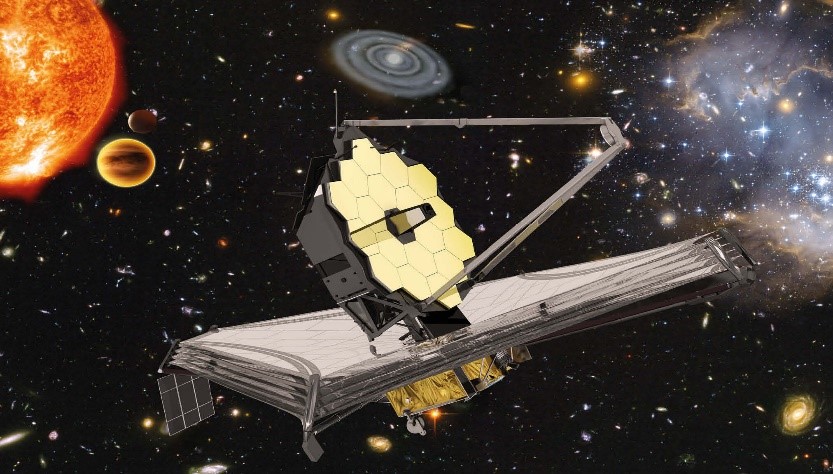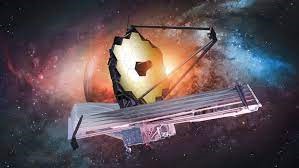Engineering Marvels of the JWST
The launch of the most powerful space observatory ever built, the James Webb Space Telescope, was again pushed back Tuesday until at least Christmas Day due to "adverse weather conditions" at the launch site in French Guiana, NASA said.

Figure 1. Engineering Marvels of the JWST
Figure 1. shows An engineering marvel, the Webb Telescope will help answer fundamental questions about the universe, peering back in time 13 billion years. Here are five things to know.
Giant gold mirror
The telescope's centerpiece is its enormous primary mirror, a concave structure 21.5 feet (6.5 meters) wide and made up of 18 smaller hexagonal mirrors. They're made from beryllium coated with gold, optimized for reflecting infrared light from the far reaches of the universe.
The observatory also has four scientific instruments, which together fulfill two main purposes: imaging cosmic objects and spectroscopy – breaking down the light into separate wavelengths to study cosmic matter's physical and chemical properties.
Million-mile journey
The telescope will be placed in orbit about a million miles from Earth, roughly four times the distance of our planet from the Moon.
Unlike Hubble, the current premier space telescope that revolves around the planet, Webb will orbit the Sun. It will remain directly behind Earth, from the point of view of the Sun, allowing it to remain on our planet's night side. Webb's sunshield will always be between the mirror and our star.
High-tech origami
Because the telescope is too large to fit into a rocket's nose cone in its operational configuration, it has to be transported folded, origami-style. Unfurling is a complex and challenging task, the most daunting deployment NASA has ever attempted. About 30 minutes after take-off, the communications antenna and solar panels supplying it with energy will be deployed.
Life, the universe, and everything
Webb has two primary scientific missions, which together will account for more than 50 percent of its observation time. First, explore the early phases of cosmic history, looking back in time to only a few hundred million years after the Big Bang.
Astronomers want to see how the very first stars and galaxies formed and how they evolved over time. Its second major goal is the discovery of exoplanets, meaning planets outside the solar system. It will also investigate the potential for life in those worlds by studying their atmospheres.
Decades in the making
Astronomers began debating the telescope that should succeed Hubble in the 1990s, with Webb's construction beginning in 2004. The launch has been pushed back several times, initially penciled for 2007, then 2018, mainly because of the complexities associated with development.
The observatory is the result of an immense international collaboration and integrates Canadian and European instruments.More than 10,000 people worked on the project, with the budget eventually snowballing to around $10 billion. The mission is set to last for at least five years, but hopefully 10 or more.[1]
1. Massive Mirror and Foldable Design:
The heart of the JWST is its massive segmented mirror, composed of 18 hexagonal gold-coated segments that work together to create a total mirror area much larger than Hubble's. To fit this large mirror into the Ariane 5 rocket for launch, engineers developed a foldable design. This required the segments to unfold and align with extraordinary precision after reaching space.
2. Sunshield:
One of the greatest challenges for an infrared telescope is managing heat. The sunshield, about the size of a tennis court, is designed to keep the telescope's instruments incredibly cold, at around -370°F (-223°C), to reduce their own infrared emissions that could interfere with the observations. The five-layer sunshield acts as a barrier between the scorching heat of the Sun and the delicate instruments of the JWST.
3. Cryocooler and Thermal Management:
While the sunshield keeps most of the telescope cold, certain components need to be colder. A cryocooler system cools the Mid-Infrared Instrument (MIRI) to even lower temperatures, allowing it to capture faint signals from distant objects. Managing these extreme temperature differences across the telescope required innovative thermal engineering solutions.
4. Precision Deployment Mechanisms:
WThe journey of the JWST doesn't end once it reaches its destination at the second Lagrange point (L2). It must unfold itself with precision, unfolding its sunshield, positioning its mirror segments, and deploying its instruments. These deployment mechanisms were meticulously designed and tested to ensure they work flawlessly in the vacuum of space.
5. Autonomous Operations:
Due to its distance from Earth (about 1.5 million kilometers away), the JWST can't be operated in real-time like the Hubble Space Telescope. Instead, it must perform many tasks autonomously. It can adjust its position, calibrate its instruments, and respond to unexpected events without human intervention, thanks to its advanced onboard software.
6. Redundancy and Reliability:
The JWST was designed with redundancy to ensure its continued operation in case of failures. Critical systems have backup mechanisms, and the telescope can continue functioning even if some components don't work as expected. This reliability is crucial for a mission with such a high cost and importance.
7. International Collaboration:
The JWST is a testament to international collaboration, with contributions from NASA, ESA, and CSA. Engineers and scientists from around the world have come together to design, build, and test the telescope's components, showcasing the power of teamwork in achieving groundbreaking feats.
In conclusion, the engineering behind the James Webb Space Telescope is nothing short of extraordinary. From its foldable design to its intricate thermal management system, the JWST's construction represents the pinnacle of human ingenuity. The successful execution of these engineering marvels is poised to open new vistas in our understanding of the cosmos, answering age-old questions and uncovering mysteries that have eluded us for generations. In the next part of this series, we'll explore the scientific instruments that will harness these engineering wonders to capture the secrets of the universe.
References:
- https://www.dailysabah.com/life/science/engineering-marvel-5-things-to-know-about-nasas-webb-telescope
Cite this article:
Gokula Nandhini K (2023), James Webb Space Telescope (JWST), AnaTechmaz, pp.2





